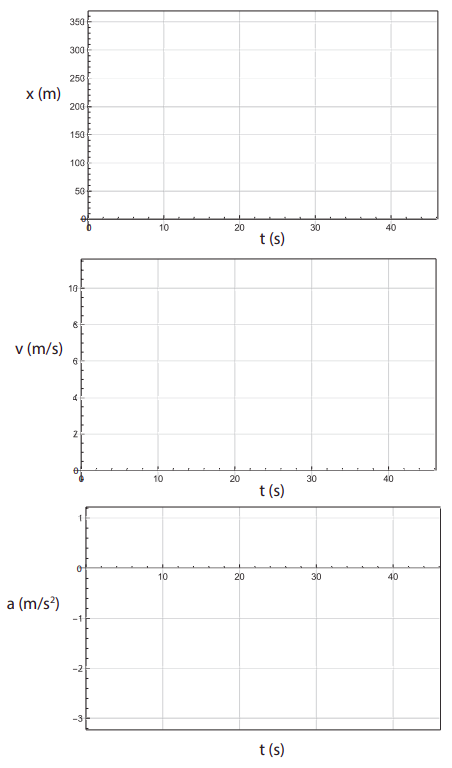2.6: Exercises
- Page ID
- 22209
Exercise \(\PageIndex{1}\)
You get on your bicycle and ride it with a constant acceleration of 0.5 m/s2 for 20 s. After that, you continue riding at a constant velocity for a distance of 200 m. Finally, you slow to a stop, with a constant acceleration, over a distance of 20 m.

- How far did you travel while you were accelerating at 0.5 m/s2, and what was your velocity at the end of that interval?
- After that, how long did it take you to cover the next 200 m?
- What was your acceleration while you were slowing down to a stop, and how long did it take you to come to a stop?
- Considering the whole trip, what was your average velocity?
- Plot the position versus time, velocity versus time, and acceleration versus time graphs for the whole trip, in the grids provided above. Values at the beginning and end of each interval must be exact. Slopes and curvatures must be represented accurately. Do not draw any of the curves beyond the time the rider stops (or, if you do, make sure what you draw makes sense!).
Exercise \(\PageIndex{2}\)
You throw an object straight upwards and catch it again, when it comes down to the same initial height, 2 s later.
- How high did it rise above its initial height?
- With what initial speed did you throw it?
(Note: for this problem you should use the fact that, if air drag is negligible, the object will return to its initial height with the same speed it had initially.)
Exercise \(\PageIndex{3}\)
You are trying to catch up with a car that is in front of you on the highway. Initially you are both moving at 25 m/s, and the distance between you is 100 m. You step on the gas and sustain a constant acceleration for a time \(\Delta t\) = 30 s, at which point you have pulled even with the other car.
- What is 25 m/s, in miles per hour?
- What was your acceleration over the 30 s time interval?
- How fast were you going when you caught up with the other car?
Exercise \(\PageIndex{4}\)
Go back to Exercise 1.6.4 of Chapter 1, and use the information in the figure to draw an accurate position vs. time graph for both runners.
Exercise \(\PageIndex{5}\)
A child on a sled slides (starting from rest) down an icy slope that makes an angle of 15\(^{\circ}\) with the horizontal. After sliding 20 m down the slope, the child enters a flat, slushy region, where she slides for 2.0 s with a constant negative acceleration of −1.5 m/s2 with respect to her direction of motion. She then slides up another icy slope that makes a 20\(^{\circ}\) angle with the horizontal.
- How fast was the child going when she reached the bottom of the first slope? How long did it take her to get there?
- How long was the flat stretch at the bottom?
- How fast was the child going as she started up the second slope?
- How far up the second slope did she slide?


